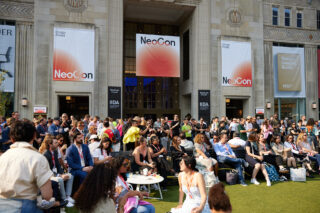Architects examine equity and optimism through structural projects at the Architecture Biennale, as designers engage in self-exploration at the Venice Design Biennal.
The Biennale Architettura 2023 (May 20 – November 26) celebrates a potential future that embraces equity and optimism, while the Venice Design Biennale (May 19 – June 18) delves into the intriguing concept of Auto-Exotic. The Architecture Biennale serves as a platform for architects worldwide to present their innovative designs, inspiring visitors to reimagine the possibilities of the built environment and shape a more inclusive future. Simultaneously, the design event, through this year’s theme, challenges designers from around the world to engage in a process of self-exploration, self-appropriation, and self-colonization.
Exploring Auto-Exoticism: Unveiling New Horizons at the Venice Design Biennale
This year’s edition of the Venice Design Biennale (May 19 to June 18, 2023), curated by Luca Berta and Francesca Giubilei, delves into the intriguing concept of Auto-Exotic. Departing from traditional notions of exoticism, this curatorial theme challenges designers from around the world to engage in a process of self-exploration, self-appropriation, and self-colonization. In an era where globalization is transforming and cultures are redefining themselves, the quest for the exotic takes on a new meaning, inviting artists to uncover the mysteries and untapped potentials within their own cultures. The Venice Design Biennale invites them to present their vision in a city that is the cradle of the concept of the exotic, a hinge between West and East, where the account of Marco Polo’s legendary journey for the first time opened new horizons to the gaze and to the imagination applied to an elsewhere beyond the limits of known experience.



NOTE: The Main Group Exhibition reveals the outcome of the Venice Design Biennial Residency, awarded this year to Australian designer Trent Jansen, who is presenting his new project in collaboration with Vetralia Collectible, editor of the work.
Shattering Orientalism:
Edward Said’s groundbreaking essay, Orientalism, published in 1978, exposed the connections between cultural investigations of the East and colonialist practices. The East, with its allure of sensuality, traditionalism, and irrationality, was often projected as a foil to the progressive, rational identity of the West. However, in recent years, the perception of “exotic” cultures has undergone a profound transformation, challenging these stereotypes. The rise of emerging powers outside the West has shattered the notion of immobile traditionalism, while Western societies are experiencing a decline in their own cultural immobility.
A Shift in Globalization:
Simultaneously, globalization as we once knew it is undergoing a significant shift. The perpetual expansion of Western capitalism, which characterized globalization, is waning. Although capitalist dominance endures, its Western manifestation is wavering, leading to a reevaluation of social and political aspects associated with it. Moreover, the interconnectedness fostered by globalization has made distant cultures and experiences readily accessible, erasing the aura of unattainable distance. This shift prompts a reconfiguration of the search for the exotic, focusing on the hidden folds of our own culture and its marginalized or avant-garde aspects.






The Designer’s Challenge:
Today, designers face the challenge of exploring this newfound otherness, both near and far. It necessitates a fresh perspective devoid of stale prejudices while retaining the radicalism required to break down outdated notions. The Venice Design Biennale serves as a platform to invite designers to present their unique visions in a city deeply rooted in the concept of the exotic. Venice, historically a bridge between East and West, symbolizes the opening of new horizons through Marco Polo’s legendary journey—an inspiration that encouraged the human gaze and imagination to transcend the confines of known experiences.
As the world undergoes transformative shifts, the concept of the exotic is being redefined. The Venice Design Biennale’s Auto-Exotic theme prompts designers to explore the depths of their own cultures, seeking inspiration in the overlooked and marginalized aspects. By transcending geographical boundaries and embracing the interplay between tradition and innovation, designers can present fresh perspectives that challenge conventional wisdom. The Biennale, set in the enchanting city of Venice, serves as a powerful catalyst for creative dialogue, forging connections between diverse cultures and celebrating the evolving nature of the exotic in contemporary design.
Products released in 2023:






The Biennale 2023 Explores the Laboratory of the Future
The Biennale Architettura 2023, curated by Lesley Lokko, presents “The Laboratory of the Future” as its central theme, inviting architects to envision a future that embraces equity and optimism. From May 20 to November 26, the exhibition will showcase groundbreaking architectural ideas at the Giardini, the Arsenale, and Forte Marghera. Lesley Lokko, a distinguished academic and founder of the African Futures Institute, brings her visionary perspective to the event, aiming to foster creativity and redefine architectural norms. The Biennale Architettura 2023 serves as a platform for architects worldwide to present their innovative designs, inspiring visitors to reimagine the possibilities of the built environment and shape a more inclusive future.
By exploring “The Laboratory of the Future,” the exhibition pushes the boundaries of traditional architecture, encouraging architects to think beyond aesthetics and consider social equity and optimism. Pre-opening activities took place on May 18 and 19, and an awards ceremony and inauguration on May 20, 2023.
Lesley Lokko has contemplated the significance of being an “agent of change” and the justification for large-scale exhibitions like the Biennale Architettura 2023. Lokko acknowledges that architecture exhibitions serve as both moments and processes, borrowing elements from art exhibitions while presenting unique considerations of production, resources, and representation. The core concept of The Laboratory of the Future, the exhibition’s central theme, revolves around the transformative power of “change.”

In a groundbreaking shift, the Biennale Architettura 2023 turns its spotlight toward Africa and the African Diaspora, acknowledging their global influence. Lokko poses crucial questions about the impact of the exhibition’s message, its ability to instigate change, and the dynamic interaction with diverse perspectives. Emphasizing the importance of multiple voices and narratives, Lokko seeks to create a rich tapestry of ideas, contexts, aspirations, and meanings that reflect the complexities of our time.
Architecture, historically dominated by exclusive voices, has neglected vast portions of humanity in terms of financial, creative, and conceptual inclusion. Lokko highlights the incomplete nature of the architectural “story” and underscores the significance of exhibitions as platforms for diverse voices and perspectives to reshape the narrative. By acknowledging the limitations of the past, exhibitions like the Biennale Architettura contribute to a more inclusive and comprehensive understanding of architecture’s role in shaping culture and society.
The exhibition “The Laboratory of the Future” is composed of six parts, featuring a diverse group of 89 participants. Over half of the participants hail from Africa or the African Diaspora, contributing to a balanced gender representation. The average age of all participants is 43, with the youngest being 24 in the Curator’s Special Projects. Notably, nearly half of the participants come from individual or small team practices of five people or less, marking a shift towards more inclusive representation.

At the core of all projects lies the essential tool of imagination. Lesley Lokko emphasizes its importance, stating that envisioning a better world is a prerequisite for building one. The exhibition begins at the Central Pavilion in the Giardini, showcasing 16 practices that embody the influential force of African and Diasporic architectural production. It then expands to the Arsenale complex, where participants in the Dangerous Liaisons section, along with the Curator’s Special Projects, create a vibrant atmosphere. This year, the Curator’s Special Projects category is of equal significance to the other sections. The venues feature the work of young African and Diasporan practitioners, referred to as Guests from the Future, who engage directly with the exhibition’s themes of decolonization and decarbonization. Their contributions offer a glimpse into future practices and perspectives, capturing the evolving nature of architecture in a rapidly hybridizing world.
In framing the participants as “practitioners” rather than limiting them to the labels of “architects,” “urbanists,” or other specialized roles, the exhibition seeks to embrace the diverse and complex conditions of Africa and the global context. This broader understanding of the term “architect” reflects the dynamic and multifaceted nature of architectural practice in the present era.










